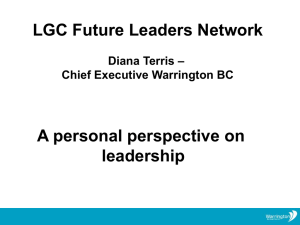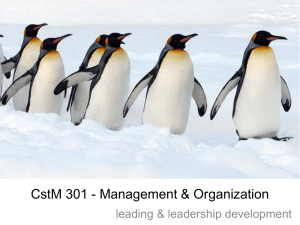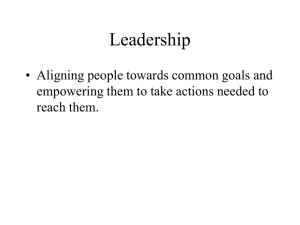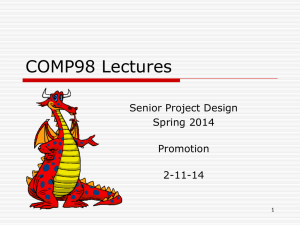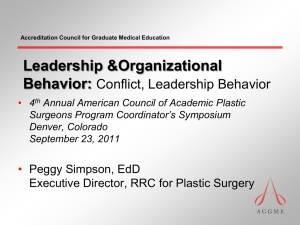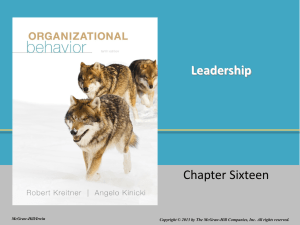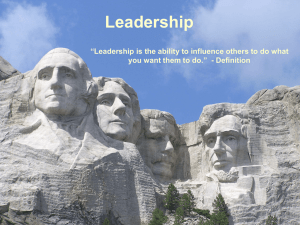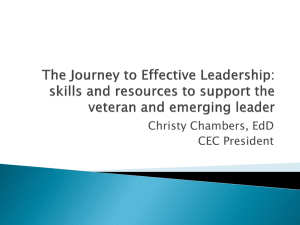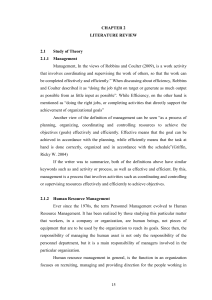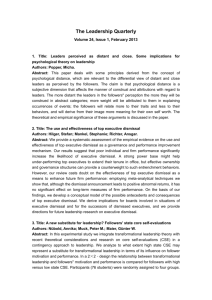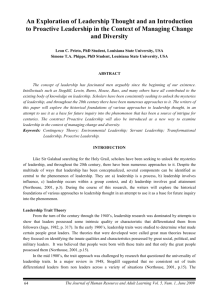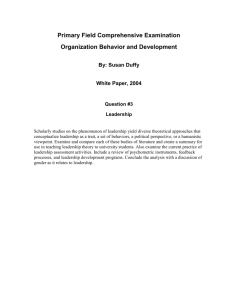I wanted to take a more refined look at my leadership
advertisement
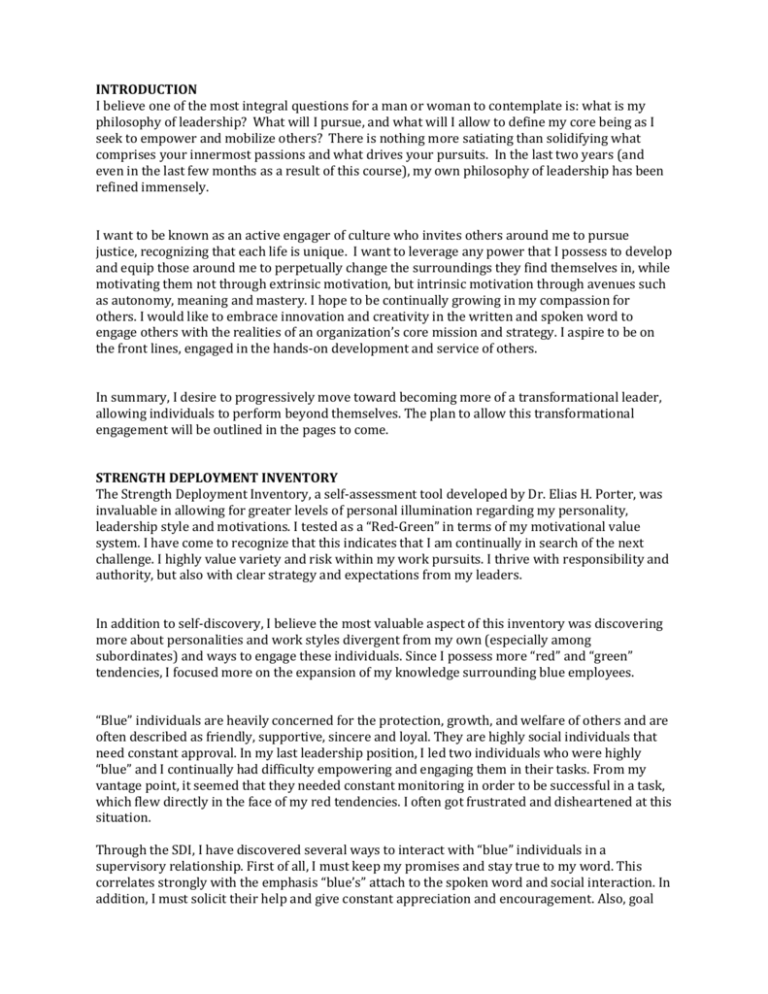
INTRODUCTION I believe one of the most integral questions for a man or woman to contemplate is: what is my philosophy of leadership? What will I pursue, and what will I allow to define my core being as I seek to empower and mobilize others? There is nothing more satiating than solidifying what comprises your innermost passions and what drives your pursuits. In the last two years (and even in the last few months as a result of this course), my own philosophy of leadership has been refined immensely. I want to be known as an active engager of culture who invites others around me to pursue justice, recognizing that each life is unique. I want to leverage any power that I possess to develop and equip those around me to perpetually change the surroundings they find themselves in, while motivating them not through extrinsic motivation, but intrinsic motivation through avenues such as autonomy, meaning and mastery. I hope to be continually growing in my compassion for others. I would like to embrace innovation and creativity in the written and spoken word to engage others with the realities of an organization’s core mission and strategy. I aspire to be on the front lines, engaged in the hands-on development and service of others. In summary, I desire to progressively move toward becoming more of a transformational leader, allowing individuals to perform beyond themselves. The plan to allow this transformational engagement will be outlined in the pages to come. STRENGTH DEPLOYMENT INVENTORY The Strength Deployment Inventory, a self-assessment tool developed by Dr. Elias H. Porter, was invaluable in allowing for greater levels of personal illumination regarding my personality, leadership style and motivations. I tested as a “Red-Green” in terms of my motivational value system. I have come to recognize that this indicates that I am continually in search of the next challenge. I highly value variety and risk within my work pursuits. I thrive with responsibility and authority, but also with clear strategy and expectations from my leaders. In addition to self-discovery, I believe the most valuable aspect of this inventory was discovering more about personalities and work styles divergent from my own (especially among subordinates) and ways to engage these individuals. Since I possess more “red” and “green” tendencies, I focused more on the expansion of my knowledge surrounding blue employees. “Blue” individuals are heavily concerned for the protection, growth, and welfare of others and are often described as friendly, supportive, sincere and loyal. They are highly social individuals that need constant approval. In my last leadership position, I led two individuals who were highly “blue” and I continually had difficulty empowering and engaging them in their tasks. From my vantage point, it seemed that they needed constant monitoring in order to be successful in a task, which flew directly in the face of my red tendencies. I often got frustrated and disheartened at this situation. Through the SDI, I have discovered several ways to interact with “blue” individuals in a supervisory relationship. First of all, I must keep my promises and stay true to my word. This correlates strongly with the emphasis “blue’s” attach to the spoken word and social interaction. In addition, I must solicit their help and give constant appreciation and encouragement. Also, goal setting must be done in a collaborative manner. I believe the greatest deficiency in my leadership of the two “blue’s” on my team was my insufficiency to stress teamwork, which is monumental for “blue’s” success and fulfillment. PATH-GOAL THEORY Path-goal theory states that a leader’s job is to help subordinates reach their goals by directing, guiding, and coaching them along the way. I think the most crucial part of Path-goal theory that is often lost is the need to be engaged enough in subordinates’ work patterns to see deficiencies in their current path. You have to be engaged. You have to be an active (and artful) listener. You have to recognize subordinates “as having their own autonomously established goals and must never be treated purely as the means to another’s personal goals.” (Northouse 387) By confirming the innate legitimacy and value that all human beings possess, a leader can learn the goals and hindrances that a subordinate is currently facing. In addition, this confirmation will also allow them to gain the respect and rapport needed to guide and coach those individuals along the intended path, and not have to rely exclusively on directing. With regard to the behaviors necessary for successful path-goal leadership, directing comes most naturally in my leadership style. Directing includes when a leader gives subordinates instructions about their task, including clarification of what is expected of them, how it is to be done, and the time line for when it should be completed. (Northouse 127) For me, this style decreases ambiguity and doubt within subordinate’s minds. However, I have discovered that this leadership behavior should not be utilized in all situations. The guidance and psychological structure that accompanies directive leadership should be used when task characteristics are ambiguous, complex and have unclear rules or when subordinates are dogmatic or are strengthened by authority. Achievement-oriented leadership is also a strength of mine. I am prone to laying out a grand vision before subordinates, one that provides deep challenge. This approach fits well with subordinates who have high expectations and a genuine drive to excel and with tasks that are ambiguous, challenging and complex. (Northouse 128) One thing about achievement-oriented leadership that I have been challenged with during this course is that merely setting a challenge before followers is not sufficient. I must also have a deep-rooted belief that those subordinates can attain that vision and provide the support and resources for them to more naturally accomplish those challenges. The two aspects of path-goal theory that have routinely manifested themselves as deficiencies in my leadership are participation and support. Supportive leadership behavior provides nurturance and is best employed with subordinates who are unsatisfied, need affiliation and human touch as well as with tasks that are repetitive, unchallenging, and mundane. (Northouse 128) As I reflect on my past leadership positions, this has rarely showed up in my behavior. In future management positions, I will seek to move toward greater levels of nurturance, recognizing that some individuals that I lead will associate that support with my level of appreciation and belief in them. Lastly, in order to successfully implement a strategy of path-goal leadership, I must improve my participation behavior. This trait revolves around a leader’s propensity to consistently consult with subordinates, obtain their ideas and opinions, and integrate their suggestions into the decisions about current strategy and mission. (Northouse 128) This is centered around a belief that each member of my team has innate gifts, resources and perspectives that are beneficial to the team. Participation allows me to honor that reality. This does not appear to be a weakness or strength in my current leadership state, but I do believe with some cultivation it could move toward an asset. VROOM-YETTON NORMATIVE DECISION MODEL All managers engage in decision making daily. Victor H. Vroom elaborates on this when he states that, “(managers’) effectiveness…is largely reflected in their track record in making the ‘right decisions’.” (Vroom) These “right decisions” are highly dependent on whether or not the manager has utilized the right individuals and the right information in the correct manner in helping resolve issues. Choosing the appropriate levels of collaboration and autocracy within decision-making has also been a struggle for me. In other words, I have never used a normative process of decision making to sift through appropriate ways to deal effectively with the problems that I have encountered in my leadership positions. In my future leadership, I will leverage the Vroom-Yetton Decision model as a tool in assisting me in the determination of the process of how a particular decision should be carried out. This “set of ground rules” matches a manager’s prospective leadership behavior to the demands of the situation. These ground rules are consistent with research evidence and the model is operational, meaning it is usable in any decision-making situation. TRANSFORMATIONAL LEADERSHIP As stated earlier, my primary goal is to progressively move toward greater levels of transformational leadership in my interactions with others. When I ponder transformational leadership, the primary attribute that rises to the top is selflessness. Burns and House (1985) described transformational leaders as those who give “more attention to follower’s needs rather than leader’s needs.” This selflessness is also addictive, as transformational leaders motivate followers to transcend their own self-interest for the good of the team and/or organization. When this occurs, a team can radically address higher-level, more challenging needs. I believe selflessness is one of the most difficult traits to constantly display in our society, but I will continually fight to curb my insatiable desire for my aspirations and wishes in favor of an emphasis on the needs and aspirations of others. The text outlined four primary transformational leadership factors that create an environment within an individual that allows for this type of influence: • Idealized Influence. This centers on a leader’s necessity to embrace high standards of moral and ethical conduct, while acting as strong role models. • • • Inspirational Motivation. This attribute revolves around a leader’s need to communicate high, lofty expectations and goals for followers. This behavior finds it hub around the inspiration of followers to commitment and engagement in shared vision. Intellectual Stimulation. This behavior allows for spaces in which followers can try new approaches and develop innovative ways of dealing with organization issues. Transformational leaders have the ability to stimulate followers to be creative and often challenge their follower’s beliefs in what is of utmost priority. Individualized Consideration. This aspect of transformational leadership involves high levels of active listening. Individualized consideration creates an environment of coaching and support that assists followers in becoming fully actualized. Of the following factors of transformational leadership, idealized influence and inspirational motivation are proven strengths. For example, in my last leadership position, where I led 3 paid staff and 50 volunteers, I continually laid out grand expectations of what our team could be. Since I believe that a vision without a plan is a mirage, I also laid out measurable steps that would move us toward that lofty vision. In addition, followers routinely mentioned that my “steadfastness in my beliefs and convictions” was the primary reason they trusted and followed me. Although I continually sought to “de-center” followers about what was of utmost priority and potentially superior ways to fulfill our vision, I rarely cultivated spaces where innovation was ripe for expansion. I will seek to enrich this in future leadership endeavors through creative brainstorming practices that we discussed in class as well as seeking to create a culture that allows for failure. With regard to individualized consideration, this is my weakest transformational leadership behavior. I often am so enamored and focused on the vision that I lose sight of the reality that the individuals that are going to get us there are being forsaken in the process. I will strive to curb this tendency by literally slotting in coaching times with followers into my calendar, pursuing a more active form of listening and seeking continuous feedback from followers, peers and leaders concerning my current levels of support. DERAILMENT TRAITS Through extensive self-assessment, I have unearthed several traits that, if not honed, could easily shift away from a strength into a weakness (as weaknesses are often strengths that are lying dormant, being abused or being overdone). One of the primary areas of potential concern rests in how I handle failure. I am what the Can You Handle Failure? Article describes as a “Micromanager”. Ben Dattner and Robert Hogan depict micromanagers as individuals who are “diligent and criticizes (themselves) for even minor errors.” The authors elaborate further by describing the micromanager as “so concerned about failure that he may suffer ‘analysis paralysis’”. I often imagine failures where none even exist. With deference to the article, I plan on adopting the following strategies to ensure that this potential derailment trait is harnessed and refined: Continuously pursuing self-assessment. During the semester, I took the following assessments: SDI, Myers-Briggs, and the Big Five. The Big Five was the most revealing, as I scored high on the achievement-striving sub-factor of the conscientiousness dimension. This correlates strongly to my discoveries of personal tendencies of becoming easily distressed and overly critical of myself if I don’t meet ambitious goals. In addition, I will ask former and current supervisors and co-workers who know me well for honest feedback on how my behavior has impacted them in the past. I will also self-reflect upon adversity – business failures, demotions, missed promotions, unchallenging jobs, and personal trauma. I will consider what how I handled these hardships and what I could have done better. Embracing new strategies. Since I have a considerable amount of illumination in this derailment trait, I think I am in a position to move toward an adaptive response. This will include a renewed commitment to active listening as well as proactive communication. Since I have a proclivity to criticizing myself for even minor errors, it is crucial that I receive enough feedback and information to gain proper perspective in order to see the entire picture. Another strategy I will actively pursue is thinking before I act. When a failure seems to have occurred, I will pause long enough to ensure that it is actually a failure in the scope of the entire project and if it is determined to be a failure, what the proper reaction should be. Also, I will do more active determination of why the failure actually happened. The article also encouraged individuals who struggled with intropunitive tendencies to push others to do their homework, share their opinions, and raise any objections in order to get a better picture of the project. DEVELOPMENTAL NEEDS I wanted to take a more refined look at my leadership strengths and areas that I am currently deficient. With that in mind, I took a self-inventory of my current state of several leadership competencies mentioned in the Northouse chapter on the Trait Approach. These competencies were compiled from Stogdill’s second survey, Kirkpatrick and Locke’s model and the five leadership traits that Northouse focuses on. Strengths/Aspects I currently possess Weaknesses/Deficiencies Composure/Selfconfidence Evenness of Temper, High selfawareness and self-monitoring, Selfassurance (even in stressful situations) Determination Resiliency until task is completed, Inner Drive, I have a life mission that frames all my actions and resists against external obstacles, Initiative, Persistence, Deep motivating passion for mission, Intrinsic motivation, Want to perform under pressure Alertness, I am always looking for reliable information sources to grow my knowledge base (serial learner), Catch on to new concepts quickly High levels of discernment, Defer decisions until ample levels of information have been processed Treats all with respect believing that all humans have inherent value and rights, Accountable, Honest, Responsibility, Lack of Mental Calmness, Tendency to over-think, Rejection or obstacles can be debilitating to me, Lack of impulse control, Rarely have a satisfied disposition, Self-confidence varies wildly depending on the situation I can sometimes cower when I do not feel confident about my skills/knowledge in a particular area Intelligence Judgment Objectivity and Integrity I have broad knowledge across numerous sectors, but not extensive knowledge in one particular arena (lack of dominant technical skills) Sometimes rely too heavily on my own judgment and not others, Let bias sway objectivity Oral Communication Planning and Organizing Resourcefulness Sociability/ Working with Others Written Communication Stick to vision/mission (not constantly changing as a result of externals), High standard of moral and ethical conduct, Very direct and deeply value truth reigning in situations I typically prepare extensively for known public speaking engagements, I avoid fillers, Asking strategic questions to obtain information, Adept in Rational Persuasion Preparation, Administration experience, Superior prioritization (creation of todo lists), Ability to naturally create filing systems, Design Workspace, Apt to eliminate clutter Strategic in convergent thinking, I believe I am a grey thinker (generalist) Ability to easily build and mend relationships, Decisiveness, Sociability (outgoing, courteous), Always keep the team focused on primary goal, I set priorities, Communicate high expectations to followers Vision fuels all my communication, captivating style Tentative at times, My success in oral communication seems to directly correlate to my confidence, I sometimes mumble/don’t pronounce clearly, I tend to interrupt, Eye contact issues, Body language communicates indifference Time management is mediocre, I underestimate the time it takes to do things Deficient in Divergent thinking Deficient at active listening (I don’t always build a supportive climate), Lack of empathy, Need for esteem is too high, Sometimes intolerant of opposing view points, Don’t usually bring a lot of technical competence into the group Sometimes too verbose, Can focus on periphery issues not central ones Below, I have listed the general competency that I believe needs diversifying, the behavioral goals that will be embraced to fill in the current gap and what I will present to potential employers to communicate the fullness of these acquired competencies. 1. Oral Communication My first action step in order to develop my oral communication skills will be to watch the 7 part online course from the University of Houston entitled: Fundamentals of Public Speaking (http://freevideolectures.com/Course/2593/Fundamental‐of‐Public‐Speaking /2). I will then debrief with classmate Matthew Dolson to ensure accountability and application. I have also asked Deb Palmer George, consultant and coach who is a crucial member of my network, to be an oral communication coach of-sorts. In this setting, we will play roles and practice verbally communicating with different individuals in an organization. We will also work on practical oral communication development through the disciplined practice of the following skills: Making eye contact. I will imagine the letter “T” on the listener’s face with the cross bar being an imaginary line across the eye brows and the vertical line coming down the center of the nose (until it becomes more natural!) Slowing down. Enunciating my words. In addition, we will maximize this time by practicing interview skills. [If Mrs. George is unable, I will look to expand my network to include someone that has specialties in this arena] My goal is to enter into transformation within this competency that optimizes my entire leadership. 2. Working with Others My main action step will revolve around the reading and processing of the following books: The Art of Collaboration: The Real Truth about Working Well with Others by Jo Ann Romero (2008), Team of Rivals: The Political Genius of Abraham Lincoln by Doris Kearns Goodwin (2005) and Primal Leadership: Realizing the Power of Emotional Intelligence by Daniel Goleman (2002). I will keep a “Working with Others” journal and use the various teams that I work on as spaces to apply what I am learning. In addition, I will make sure I can succinctly communicate these lessons in an interview setting for future employers. 3. Resourcefulness In a Whole New Mind, Daniel Pink (2003) asserts that the predominantly left-brain thinking (seeking rational, systemic, and predictable patterns), characteristic of the United States in the 20th Century, is no longer sufficient in this new century. We also have become victims of our own achievements as individuals and within organizations so we default to ways of thinking and acting that have made us successful in the past. The development of my resourcefulness competency revolves heavily around my ability to improve my creativity by engaging in both divergent and convergent thinking, embracing both the left and right sides of my brain. I am more versed in convergent thinking, so my focus here will be developing behaviors that allow me to grow in divergent thinking. Diane Halpern in her book, Thought and Knowledge, (2005) presents the following as key elements of creative thinking: · Stretching and rejecting paradigms · Problem finding · Selecting relevant information · Generation, exploration, and evaluation · Insight and incubation · Analogical thinking (lateral versus vertical) My first action step will be to actively engage in this creative thinking process for 3 of the most pressing open-ended problems that face Preston Taylor Ministries, a non-profit organization I currently assist with after-school tutoring. With at least one of those problems, I will engage in a brainstorming session with a paid staff member, another volunteer and a parent of a tutored child. While I am entering into divergent thinking over these problems, I will implement a few creative thinking suggestions I have recently read about, including: Concentrating on the problem longer than seems natural. People often jump to answers too quickly before they've really thought about the question. Research suggests that spending time re-conceptualizing the problem is beneficial. Mumford et al. (1994) found that experimental participants produced higher quality ideas when forced to re-conceive the problem in different ways before trying to solve it. This will increase the likelihood that I am asking the right question. Reading Alice in Wonderland, Kafka’s Metamorphosis, or another absurdist masterpiece before creatively thinking about the problem. Absurdity is described as a “meaning threat” which allows for the stretching of paradigms and a corresponding enhancement of creativity. This is as a result of a study in which participants read an absurd short story by Franz Kafka before completing a pattern recognition task. Compared with control participants, those who had read the short story showed an enhanced subconscious ability to recognize hidden patterns. Practice the distant condition. Recent studies have revealed that increasing psychological distance, even by simply stating that the source of the problem came from a distance away, increases creative thoughts and insights. It even notes that simply changing the way individuals think about a problem – or their perceptions of the problem can artificially produce distance. I need to get far away from the problem, and supplant the potential solutions in distant places to raise the likelihood of creativity. Per his request, I will provide the Executive Director, Chan Sheppard, with a detailed outline of the thinking process and potential solutions to the current problem. In addition, I will be able to share the process and ensuing results to the Department of State during my interview to demonstrate strategic resourcefulness. In addition, I plan to strengthen my intermediate Spanish language skills through NotesinSpanish (a free online tool), free MIT resources as well as Spanish Learning CD’s that will allow me to maximize my hour-long round-trip work commute. I will also plan on reading one Spanish article a week, while communicating the main idea of each article to my wife in Spanish. Recent research has shown that learning a second language is a great way to improve creativity, by creating new neural pathways between the right and left brain. (Gilkey & Kilts, 2007) 4. Composure/Self-Confidence Compared to each of the other skill areas, this will be much more of a processing of past behavior in order to increase personal awareness. In order to do that I will pursue the following: 1. I will ask former and current supervisors and co-workers who know me well for honest feedback on how my behavior has impacted them in the past. 2. I will self-reflect upon adversity – business failures, demotions, missed promotions, unchallenging jobs, and personal trauma. I will consider what I learned as a result of these hardships and how it has shaped my interactions. One behavior goal is to participate in a leadership development program that features selfawareness and reflection while asking for feedback on a multi-rater assessment. I will begin researching such a setting in January 2012. WORKS CITED Dean, J. (March 30, 2010). Boost Creativity: 7 Unusual Psychological Techniques. In PsyBlog. Retrieved November 4, 2011, from http://www.spring.orgcreativity‐7‐unusual ‐psychological‐techniques.php. Gilkey, R., & Kilts, C. (2007). Cognitive Fitness. Boston: Harvard Business Review. Halpern, Diane F. (2003). Creative Thinking in Thought & Knowledge: An Introduction to Critical Thinking. Mahway, New Jersey: Lawrence Erlbaum Associates. Heine, S. J., & Proulx, T. (2009). Connections from Kafka. In Psychological Science. Retrieved November 4, 2011, from http://pss.sagepub.com/content/20/9/1125. Northouse, Peter G. (2010) Leadership: Theory and Practice- 5th Edition. Thousand Oaks: Sage Publications. Pink, Daniel. (2005). A Whole New Mind. New York: Riverhead Books. In addition, I used the following class articles that I did not have bibliographical information on: A New Look at Managerial Decision Making by Victor H. Vroom Can You Handle Failure by Ben Dattner and Robert Hogan Cognitive Fitness by Roderick Gilkey and Clint Kilts Stop Overdoing Your Strengths by Robert E. Kaplan and Robert B. Kaiser The Creativity Crisis by Po Bronson and Ashley Merryman.
